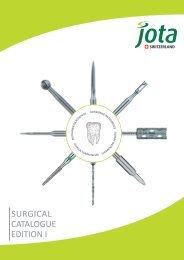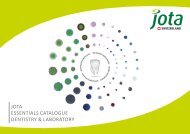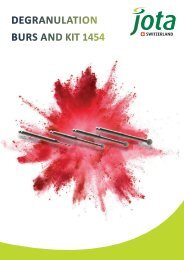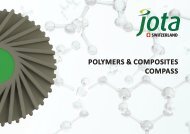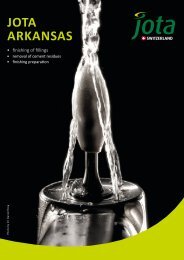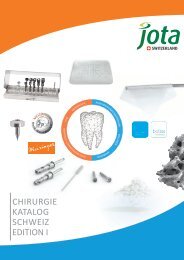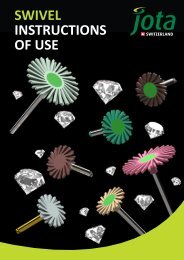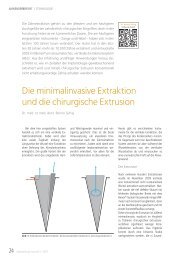PRP CONZEPT
You also want an ePaper? Increase the reach of your titles
YUMPU automatically turns print PDFs into web optimized ePapers that Google loves.
PRECISE RELIABLE<br />
PREPARATION CONCEPT<br />
1
PRECISE RELIABLE<br />
PREPARATION CONCEPT<br />
The shape of the prepared teeth and the<br />
amount of tooth structure removed are essential<br />
factors for the mechanical, biological,<br />
and aesthetic success of fixed ceramic<br />
restorations [3,4]. The growing demand for<br />
esthetical results and CAD-CAM production<br />
leads to more challenges for dentists<br />
to form high-quality tooth preparation.<br />
The preparation design for ceramics often<br />
requires the elimination of all undercuts,<br />
defined restoration thickness, and a shape<br />
that promotes retention and resistance.<br />
Preparing teeth for fixed prostheses is one<br />
of the most failed dental procedures [5].<br />
Most failures in ceramic can be avoided by<br />
understanding the properties of the material<br />
and accordingly preparing the tooth<br />
and handling the laboratory procedures<br />
[6].<br />
A precise, reliable preparation concept<br />
(<strong>PRP</strong>) proposes an intuitive, easy-to-operate,<br />
and restoration parameterization-based<br />
approach to modeling tooth preparation.<br />
<strong>PRP</strong> concept design was developed to<br />
help dentists quickly define the thickness<br />
of restoration in the different tooth levels,<br />
which can reduce the complexity of the<br />
tooth preparation process and improve its<br />
quality and efficiency.<br />
This concept included six different types of<br />
diamond burs :<br />
• Depth markers for anterior teeth<br />
• Depth markers for posterior teeth<br />
• Depth markers for incisal edges, lingual<br />
& occlusal surfaces<br />
• Multi-radius burs for posterior teeth<br />
• Multi-radius burs for anterior teeth<br />
• Multi-radius margin refinement burs<br />
2
The basic procedure of <strong>PRP</strong> concept consists<br />
of different depth markers which set<br />
the thickness of the preparation for the<br />
different types of crowns. The marking<br />
burs create grooves on the various tooth<br />
surfaces, and then the dentist reduces the<br />
dental hard tissue with conical multi-radius<br />
burs to this level. In the finishing stage,<br />
the red diamonds are used for smoothing<br />
all preparation surfaces, and the special<br />
marginal burs finish only the shoulders.<br />
anterior teeth preparation<br />
posterior teeth preparation<br />
depth-markers bulk preparartion margin refinement<br />
3
DEPTH MARKERS BURS<br />
POSTERIOR & ANTERIOR TEETH<br />
INCISAL EDGES, LINGUAL &<br />
OCCLUSAL SURFACES<br />
One of the essential preparation rules is<br />
an adequate occlusal reduction. Inadequate<br />
occlusal preparation is as harmful<br />
as over-preparation. The insufficient<br />
occlusal reduction will provide limited<br />
space for ceramic, leading to weak areas<br />
prone to fracture [7,8]. Using depth markers<br />
for incisal edges, lingual & occlusal<br />
surfaces will avoid this problem.<br />
The depth markers are available in cylindrical<br />
and conical shapes and 0.9 mm and<br />
1.7 mm thicknesses for the different tooth<br />
groups. 828 burs with diameter 017 are<br />
used for posterior teeth preparation and<br />
diameter 009 for small teeth and premolars,<br />
respectively. The conical shape 828T<br />
has a cone from 8 grads and can also be<br />
used for onlay and inlay preparations.<br />
4
828TW.FGS.017 828W.FGL.009 828W.FGL.017<br />
1 mm<br />
for maxillary anterior lingual and<br />
axial, monolithic opaque zirconia<br />
806313501524010 806315501524010 806315500524010<br />
828TG.FGS.017 828G.FG.009 828G.FG.017<br />
1,5 mm<br />
for monolithic opaque zirconia<br />
806313501524015 806314501524015 806314500524015<br />
828TO.FGS.017 828O.FG.009 828O.FG.017<br />
1,8 mm<br />
for monolithic translucent zirconia<br />
806313501524018 806314501524018 806314500524018<br />
828TY.FGS.017 828Y.FG.009 828Y.FG.017<br />
2,0 mm<br />
for e.max, layered porcelain,<br />
monolithic porcelain,<br />
incisal reduction<br />
806313501524020 806314501524020 806314500524020<br />
828TB.FGS.017 828B.FG.009 828B.FG.017<br />
2,2 mm<br />
for layered porcelain,<br />
0.7 mm Core + 1.5 mm Veneer<br />
806313501524022 806314501524022 806314500524022<br />
828TR.FGS.017 828R.FG.009 828R.FG.017<br />
2,4 mm<br />
for layered porcelain, incisal reduction<br />
806313501524024 806314501524024 806314500524024<br />
5
DEPTH MARKERS BURS<br />
POSTERIOR & ANTERIOR TEETH<br />
VESTIBULAR SURFACE<br />
Depth markers for anterior teeth have<br />
three tiers and posterior two tiers, respectively.<br />
A guided pin helps to position<br />
the bur on the tooth. The WD560 burs are<br />
used for depth marking of the veneers.<br />
The WD834 and WD510 burs are used<br />
for depth limiting of different crowns.<br />
Depth markers for labial surfaces of posterior<br />
and anterior teeth are an accurate<br />
method for quantifying tooth tissue reduction<br />
for a fixed prosthodontic preparation.<br />
Proper tooth tissue reduction makes it<br />
easier for a laboratory technician to create<br />
esthetic restorations with natural color<br />
and translucency. The best reduction<br />
can be achieved by placing depth grooves<br />
into the surface to be reduced and then<br />
reducing the tooth following the grooves<br />
[3].<br />
Another problem that depth markers<br />
solve is the convergence angle. Nuha<br />
et al. [2] analyzed the quality of models<br />
prepared by senior dental students. The<br />
results showed that the average convergence<br />
angle was 39.98° and the average<br />
buccal and lingual convergence angle was<br />
44.1°, which deviated significantly from<br />
the ideal convergence angle of between<br />
4° and 10° proposed by Petal et al. [1].<br />
The abovementioned problems result in<br />
difficulties in the operation for the dentists,<br />
which leads to low accuracy and efficiency<br />
of the preparation and seriously<br />
affects the restoration quality with fixed<br />
prostheses [4]. Depth markers have predefined<br />
angles and depths in the different<br />
tooth levels, which help dentists to<br />
achieve the correct convergence easily.<br />
Over-preparation is another mistake that<br />
dentists often tend to make [6]. Overpreparation<br />
reduces the retention of the<br />
restorations and inherent strength of the<br />
remaining tooth and can cause damage<br />
to the pulp [7]. The rule is that only as<br />
much tooth structure as required should<br />
be removed. Depth markers for different<br />
crowns prevent over-preparation of the<br />
tooth.<br />
6
ANTERIOR TEETH<br />
veneer preparation<br />
WD560.FG.018<br />
WD560.FG.021<br />
806314560524018<br />
Depth 0.25/0.25/0.25 mm<br />
806314560524021<br />
Depth 0.4/0.4/0.4 mm<br />
minimal standard extensive<br />
WD834.FG.025<br />
WD834.FG.031<br />
WD834.FG.035<br />
Depth 0.8<br />
Depth 1.0<br />
Depth 1.2<br />
806314834524025<br />
Depth 0.3/0.5/0.7 mm<br />
806314834524031<br />
Depth 0.5/0.7/0.9 mm<br />
806314834524035<br />
Depth 0.8/1.0/1.2 mm<br />
7
ANTERIOR TEETH<br />
minimal standard extensive layered<br />
WD510.FG.026<br />
WD510.FG.030<br />
WD510.FG.034<br />
WD510.FG.046<br />
806314510524026<br />
806314510524030<br />
806314510524034<br />
806314510524046<br />
Depth 0.3/0.5/0.7 mm Depth 0.5/0.7/0.9 mm Depth 0.8/1.0/1.2 mm Depth 1.0/1.2/1.5 mm<br />
8
POSTERIOR TEETH<br />
high strength<br />
monolithic<br />
low strength<br />
monolithic<br />
layered<br />
WD511.FG.036<br />
WD511.FG.040<br />
WD511.FG.045<br />
806314511524036<br />
Depth 0.5/1.0 mm<br />
806314511524040<br />
Depth 0.8/1.2 mm<br />
806314511524045<br />
Depth 1.0/1.5 mm<br />
9
MULTI-RADIUS BURS<br />
POSTERIOR & ANTERIOR TEETH<br />
BULK REDUCTION<br />
Multi-radius burs were developed to improve<br />
the preparation of shoulder margins.<br />
The use of single-radius burs can<br />
lead to what is called a J margin with an<br />
unsupported enamel lip [8]. Such a margin<br />
is difficult to scan for a CAD-CAM procedure<br />
and not acceptable for ceramic preparation<br />
[6].<br />
At the same time, using square burs can<br />
lead to stepping or leaving behind sharp<br />
lines and point angles in the preparation,<br />
which interferes marginal adaptation of<br />
the crown. An acute internal line angle<br />
can cause undue stress, initiate fracture,<br />
and cause fit problems [6,8,3]. All angles<br />
should be rounded on all-ceramic tooth<br />
preparations to increase crown strength<br />
[3]. The multi-radius burs smoothen the<br />
edges of shoulder and prevent the abovementioned<br />
errors.<br />
Multi-radius burs are available in three<br />
different diamond grits: very coarse, medium,<br />
and fine, and in two working part<br />
lengths of 6.0 and 8.0 mm for posterior and<br />
anterior teeth preparation. Depending on<br />
the type of crown, there are four diameter<br />
burs for posterior teeth (012, 016, 018,<br />
020) and three for anterior teeth preparation<br />
(014, 018, 020).<br />
MULTI-RADIUS DESIGN<br />
NO STEPPING, LIPPING AND SHARP POINTS<br />
ROUNDED EDGES<br />
PREDICTABLE ROBUST CERAMIC RESTAURATION<br />
6 & 8 mm LENGTHS<br />
FOR POSTERIOR AND ANTERIOR BULK PREPARATION<br />
10
Without radius<br />
One-radius<br />
Multi-radius<br />
MARGIN PREPARATION<br />
Stepping<br />
J Margin<br />
rounded Shoulder<br />
11
POSTERIOR TEETH<br />
BULK REDUCTION AND SEPARATION<br />
WD203SG.FG.012 WD203SG.FG.016 WD203SG.FG.018 WD203SG.FG.020<br />
806314203544012 806314203544016 806314203544018 806314203544020<br />
WD203.FG.016 WD203.FG.018 WD203.FG.020<br />
806314203524016 806314203524018 806314203524020<br />
WD203F.FG.012 WD203F.FG.016 WD203F.FG.018 WD203F.FG.020<br />
806314203514012 806314203514016 806314203514018 806314203514020<br />
12
ANTERIOR TEETH<br />
BULK REDUCTION<br />
WD204SG.FG.014 WD204SG.FG.018 WD204SG.FG.020<br />
806314204544014 806314204544018 806314204544020<br />
WD204.FG.014 WD204.FG.018 WD204.FG.020<br />
806314204524014 806314204524018 806314204524020<br />
WD204F.FG.014 WD204F.FG.018 WD204F.FG.020<br />
806314204514014 806314204514018 806314204514020<br />
13
MULTI-RADIUS BURS<br />
MARGIN REFINEMENT<br />
All preparation shoulders should always be<br />
smoothened. Rough shoulders are not just<br />
challenging to scan but also difficult for the<br />
technician to work on. A smooth shoulder<br />
guarantees an excellent fit, minimal cement<br />
line, and pleasing aesthetics. It also<br />
reduces unnecessary stress at the margins<br />
caused by a rough shoulder [6].<br />
It is recommended at the end of the preparation,<br />
an end-cutting diamond must be<br />
run over the margins to smooth them [9].<br />
There are three margin refinement burs<br />
with 0.6, 1.2, and 1.6 mm diameters. They<br />
are diamonded only on the top and do not<br />
change other preparation surfaces.<br />
WD839F.FG.006<br />
WD839F.FG.012<br />
WD839F.FG.014<br />
806314839514006<br />
806314839514012<br />
806314839514014<br />
14
REFERENCES<br />
1. P.B. Petal, D.G. Wildgoose, R.B. Winstanley, Comparison of convergence angles achieved in posterior<br />
teeth for full veneer crowns, Eur. J. Prosthodont. Restor. Dent., 13 (2005) 100-104.<br />
2. E.M. Nuha, A.B. Neamat, O. Osama, I. Yahia, Assessment of undergraduate students‘ tooth preparation<br />
for full veneer cast restorations, Open J. Stomatol., 4 (2014) 43-48.<br />
3. Goodacre CJ. Designing tooth preparations for optimal success. Dent Clin North Am. 2004 Apr;48(2):v,<br />
359-85. doi: 10.1016/j.cden.2003.12.015. PMID: 15172605.<br />
4. Dai N, Zhong Y, Liu H, Yuan F, Sun Y. Digital modeling technology for full dental crown tooth preparation.<br />
Comput Biol Med. 2016 Apr 1;71:190-7. doi: 10.1016/j.compbiomed.2016.02.008. Epub 2016 Feb<br />
22. PMID: 26945598.<br />
5. Hoffman JM. Modern concepts in crown preparation. N Y State Dent J. 1991 Aug-Sep;57(7):32-5.<br />
PMID: 1923146.<br />
6. Shetty, Rohit & Bhat, Sonia. (2010). Rectifying the Tooth Preparation Errors in All-Ceramic Restorations<br />
Rectifying the Tooth Preparation Errors in All-Ceramic Restorations. world journal of dentistry. 1. 181-<br />
185. 10.5005/jp-journals-10015-1036.<br />
7. Gordon J Chistensen. Frequently encountered errors in tooth preparations for crowns. J Am Dent Assoc<br />
2007;138(10): 1373-78.<br />
8. Damon C Adams. The ten most common all ceramic preparation errors: A doctor/technician liason’s<br />
perspective; dentistry today Oct 2004;23(10):94,96-99.<br />
9. Rosenblum MA, Schulman A. A review of all-ceramic restorations. J Am Dent Assoc 1997;128;297-307.<br />
SUBSCRIBE OUR CHANNELS<br />
15
16




